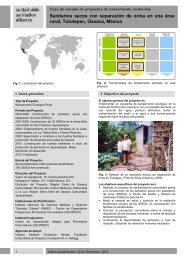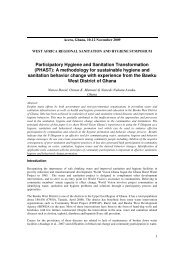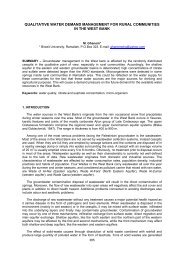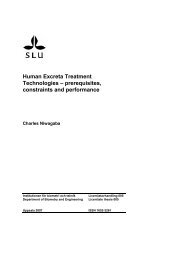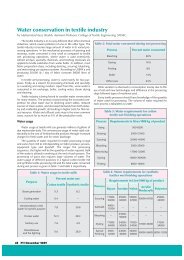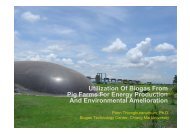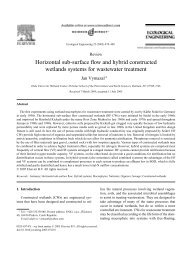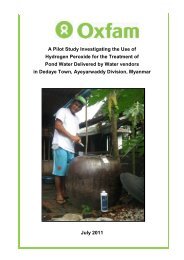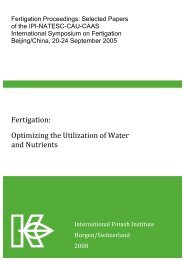Experiences with urine diverting dry toilets - EcoSan Club
Experiences with urine diverting dry toilets - EcoSan Club
Experiences with urine diverting dry toilets - EcoSan Club
Create successful ePaper yourself
Turn your PDF publications into a flip-book with our unique Google optimized e-Paper software.
Elegant yet Economical UDDTs in Ecuador<br />
Figure 1: UDDT Design. Interior dimensions<br />
were 120 cm long by 90 cm wide<br />
4. Collection and storage of <strong>urine</strong>. Urine is collected in a<br />
funnel made from a carefully cut 4 liter white plastic<br />
bottle (which may have once contained chlorine). A<br />
plastic mesh is sewn <strong>with</strong> fishing line, 5mm below<br />
its sloped opening, to prevent feces and solids from<br />
going in. The mouth of the bottle fits into an elbow of<br />
a 5 cm PVC pipe which passes through the side wall<br />
and is inserted into a 5-cm hole in a plastic beverage<br />
bottle, <strong>with</strong> a hose glued into its mouth that goes to<br />
the bottom of a 20 liter plastic bottle for storage, thus<br />
avoiding ammonia emissions in the direction of the user<br />
(Figure 4).<br />
5. Collection and storage of feces. Feces are collected in a<br />
rice sack that is held open by four elastic strings attached<br />
to the walls (Figure 4). Dry material (e.g., wood ash,<br />
sawdust, rice hulls) is added manually, using a cup, after<br />
each use. When it is full or starting to get heavy, the user<br />
ties it shut, marks it <strong>with</strong> the date, and puts it under the<br />
floor for six months in order for any pathogens present<br />
to die (given the tropical location; the rule of thumb for<br />
temperate countries is one year). Dried feces, which<br />
may be periodically examined under the microscope for<br />
ameba cysts and helminth eggs, can be used to improve<br />
soils or to cover new deposits of feces. Advantages of rice<br />
sacks include: concentrating feces and cover material<br />
so that feces are covered better; gas exchange through<br />
the cloth of the sack allowing water to evaporate out<br />
and oxygen to penetrate in; accessibility; and low cost.<br />
Nonetheless, if users prefer, buckets or other containers<br />
may replace the sacks.<br />
6. Measurements. The inside dimensions are 0,8 m wide,<br />
1,2 m long, and 1.9 m high (entrance door). This small<br />
space is sufficient for user comfort, and also allows for<br />
5cm clearance on each side of the roof to prevent rain<br />
Sustainable Sanitation Practice<br />
25<br />
damage to the walls, given that the roofing was 1.1 m<br />
wide.<br />
7. Doors. The front and back doors are made of painted<br />
wood and are 0.8 m wide, in order to fit directly in<br />
between the two side walls.<br />
8. Ventilation. Front and rear windows, made <strong>with</strong><br />
wooden frames and mosquito screen, let light and air<br />
into the room. A PVC vent pipe (0.11 m x 3 m) creates a<br />
flow of air away from the user, removing any odors. The<br />
top of the vent pipe is cut at a steep angle and covered<br />
<strong>with</strong> a metallic mesh. (In other locations, <strong>with</strong> warm,<br />
humid climates, a 0.16 m pipe is used.) The chamber<br />
should be as air-tight as possible, so that the draft pulls<br />
air consistently into the drop hole.<br />
Figure 2: Ferrocement floor and bench before<br />
adding concrete. The brown plank forms have no<br />
need for holes. (Photo: C. Thibodeau)<br />
Figure 3: Seat, funnel and sack. The yellow plastic<br />
mesh keeps solids out of the funnel. Note that<br />
the rice sack, in this case, is too high. (Photo: C.<br />
Thibodeau)<br />
Figure 4: View of back door. Note the plastic bottle<br />
that collects <strong>urine</strong> and that the spaces around the<br />
door frame should be filled. (Photo: C. Canaday)<br />
Issue 6/2011



